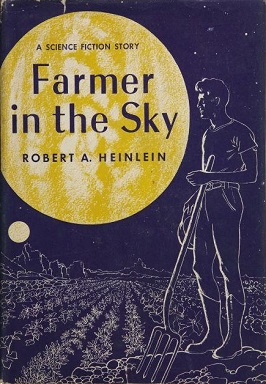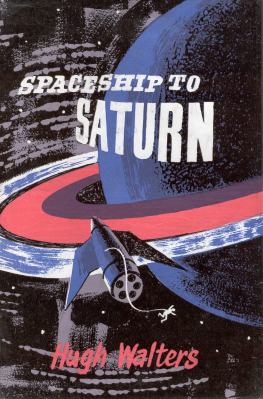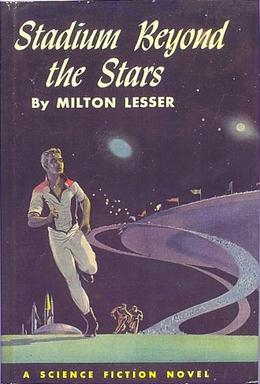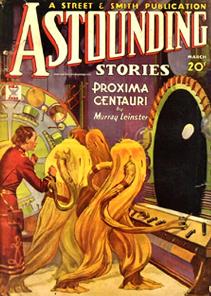Superluminal communication is a hypothetical process in which information is conveyed at faster-than-light speeds. The current scientific consensus is that faster-than-light communication is not possible, and to date it has not been achieved in any experiment.

Rocket Ship Galileo, a juvenile science-fiction novel by the American writer Robert A. Heinlein, published in 1947, features three teenagers who participate in a pioneering flight to the Moon. It was the first in the Heinlein juveniles, a long and successful series of science-fiction novels published by Scribner's. Heinlein originally envisioned the novel as the first of a series of books called "Young Rocket Engineers". Publishers initially rejected the script, judging going to the moon as "too far out".

Space Cadet is a 1948 science fiction novel by Robert A. Heinlein about Matt Dodson, who joins the Interplanetary Patrol to help preserve peace in the Solar System. The story translates the standard military academy story into outer space: a boy from Iowa goes to officer school, sees action and adventure, shoulders responsibilities far beyond his experience, and becomes a man. It was published as the second of the series of Heinlein juveniles and inspired the media franchise around the character Tom Corbett, including the 1950s television series Tom Corbett, Space Cadet and radio show which made "Space Cadet" a household phrase whose meaning later shifted in popular culture.

Between Planets is a juvenile science fiction novel by American writer Robert A. Heinlein, originally serialized in Blue Book magazine in 1951 as "Planets in Combat". It was published in hardcover that year by Scribner's as part of the Heinlein juveniles.

Citizen of the Galaxy is a science fiction novel by American writer Robert A. Heinlein, originally serialized in Astounding Science Fiction and published in hardcover in 1957 as one of the Heinlein juveniles by Scribner's. The story is heavily influenced by Rudyard Kipling's Kim.

Farmer In The Sky is a 1950 science fiction novel by American writer Robert A. Heinlein about a teenaged boy who emigrates with his family to Jupiter's moon Ganymede, which is in the process of being terraformed. Among Heinlein's juveniles, a condensed version of the novel was published in serial form in Boys' Life magazine, under the title "Satellite Scout". The novel was awarded a Retro Hugo in 2001.

Orphans of the Sky is a science fiction novel by American writer Robert A. Heinlein, consisting of two parts: "Universe" and its sequel, "Common Sense". The two novellas were first published together in book form in 1963. "Universe" was also published separately in 1951 as a 10¢ Dell paperback. The work presents one of the earliest fictional depictions of a generation ship.

The Future History is a series of stories created by Robert A. Heinlein. It describes a projected future of the human race from the middle of the 20th century through the early 23rd century. The term Future History was coined by John W. Campbell Jr. in the February 1941 issue of Astounding Science Fiction. Campbell published an early draft of Heinlein's chart of the series in the May 1941 issue.

Variable Star is a 2006 science fiction novel by American author Spider Robinson, based on the surviving seven pages of an eight-page 1955 novel outline by the late Robert A. Heinlein. The book is set in a divergent offshoot of Heinlein's Future History and contains many references to works by Heinlein and other authors. It describes the coming of age of a young musician who signs on to the crew of a starship as a way of escaping from a failed romance. Robinson posted a note on his website in 2009 noting that his agent had sold a trilogy of sequels based on the novel and its characters.

World of Ptavvs is a science fiction novel by American writer Larry Niven, first published in 1966 and set in his Known Space universe. It was Niven's first published novel and is based on a 1965 magazine story of the same name.

The hypothetical particles tachyons have inspired many occurrences of in fiction. The use of the word in science fiction dates back at least to 1970 when James Blish's Star Trek novel Spock Must Die! incorporated tachyons into an ill-fated transporter experiment.
The Heinlein juveniles are the science-fiction novels written by Robert A. Heinlein for Scribner's young-adult line. Each features "a young male protagonist entering the adult world of conflict, decisions, and responsibilities." Together, they tell a loosely connected story of space exploration. Scribner's published the first 12 between 1947 and 1958, but rejected the 13th, Starship Troopers. That one was instead published by Putnam. A 14th novel, Podkayne of Mars, is sometimes listed as a "Heinlein juvenile", although Heinlein himself did not consider it to be one.

Spaceship to Saturn is a juvenile science fiction novel, the tenth in Hugh Walters' "Chris Godfrey of U.N.E.X.A." series. It was published in 1967 in the UK by Faber and in the US by Criterion Books and in Portugal under the title Voo para Saturno by Edições Dêagã in 1975.

Stadium Beyond the Stars is a juvenile science fiction novel by Milton Lesser published in 1960 by Holt, Rinehart & Winston with cover illustration by Mel Hunter. The story follows the adventures of Steve Frazer, a champion spacesuit racer on Earth's Olympic team, as the ship taking him and the rest of the team to the center of the galaxy for the Interstellar Olympic Games intercepts a mysterious derelict spaceship. Stadium Beyond the Stars is a part of the Winston Science Fiction set, a series of juvenile novels which have become famous for their influence on young science fiction readers and their exceptional cover illustrations by award winning artists.

"Proxima Centauri" is a science fiction short story by American writer Murray Leinster, originally published in the March 1935 issue of Astounding Stories. Unusually for the time, the story adhered to the laws of physics as they were known by showing a starship that was limited by the speed of light and took several years to travel between the stars. In his comments on the story in Before the Golden Age, Isaac Asimov thought that "Proxima Centauri" must have influenced Robert A. Heinlein's later story "Universe" and stated that it influenced his own Pebble in the Sky.

To the Stars is a science fiction novel by American writer L. Ron Hubbard. The novel's story is set in a dystopian future, and chronicles the experiences of protagonist Alan Corday aboard a starship called the Hound of Heaven as he copes with the travails of time dilation from traveling at near light speed. Corday is kidnapped by the ship's captain and forced to become a member of their crew, and when he next returns to Earth his fiancee has aged and barely remembers him. He becomes accustomed to life aboard the ship, and when the captain dies Corday assumes command.
"The Game of Rat and Dragon" is a science fiction short story by American author Cordwainer Smith, written in 1954 and published in Galaxy Science Fiction in 1955. It is set in the far future, though no date is given. It occurs in the same universe as other Cordwainer Smith novels, with a passing reference to the super-powerful regulatory 'Instrumentality'.
Space travel under constant acceleration is a hypothetical method of space travel that involves the use of a propulsion system that generates a constant acceleration rather than the short, impulsive thrusts produced by traditional chemical rockets. For the first half of the journey the propulsion system would constantly accelerate the spacecraft toward its destination, and for the second half of the journey it would constantly decelerate the spaceship. Constant acceleration could be used to achieve relativistic speeds, making it a potential means of achieving human interstellar travel. This mode of travel has yet to be used in practice.

Beyond the Blue Event Horizon is a science fiction novel by the American writer Frederik Pohl, a sequel to his 1977 novel Gateway and the second book in the Heechee series. It was a finalist for two major annual awards, the 1981 Hugo Award for Best Novel and the 1980 Nebula Award. In the 1981 poll of Locus readers it finished second to The Snow Queen by Joan Vinge.

Space travel, or space flight is a classic science-fiction theme that has captivated the public and is almost archetypal for science fiction. Space travel, interplanetary or interstellar, is usually performed in space ships, and spacecraft propulsion in various works ranges from the scientifically plausible to the totally fictitious.















